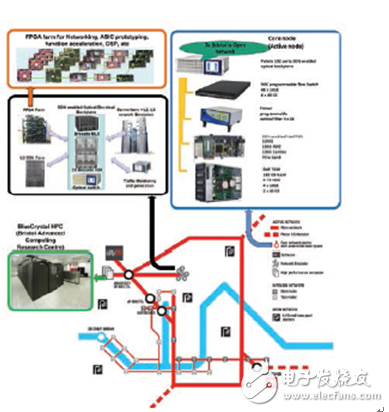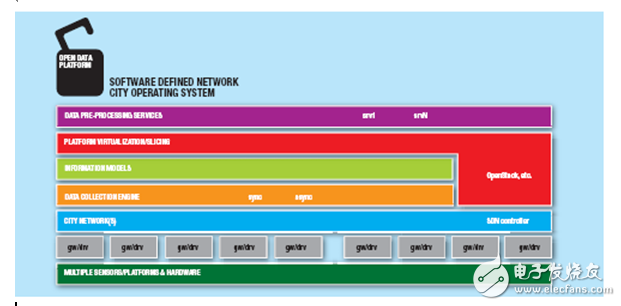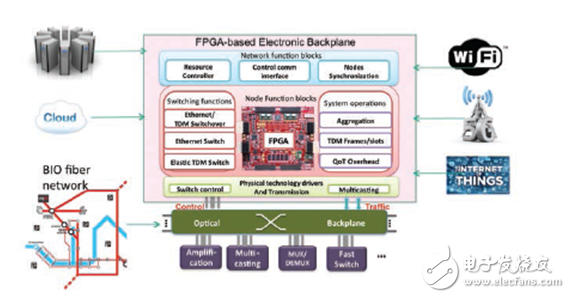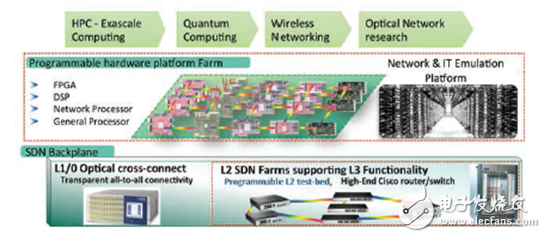Bristol, UK has become a pilot city for smart city technology. The Bristol Is Open project is a life laboratory in the development of the Internet of Things.
By 2050, the world's population will reach 9 billion, and urban residents will account for 75%. About 80% of the UK's population lives in urban areas, so the UK needs to ensure that cities adapt to the digital age. Smart cities help create an efficient, sustainable, cleaner environment, a higher quality of life and a thriving economy.
To this end, the Bristol Is Open (BIO) joint venture between Bristol University and Bristol City collaborates with industry, universities, local communities and local and national government agencies. Bristol Is Open () is pushing this southwestern city of England with a population of 500,000 to become the world's first programmable city.
Bristol will be an open testing ground for the vibrant new industrial Internet of Things (part of the smart city infrastructure) market. The Bristol Is Open project uses Xilinx All Programmable FPGA devices in many development and deployment areas.
Smart city vision
Smart cities use information and communication networks and Internet technologies to solve urban problems with the goal of dramatically improving livability and resource sustainability. Forecasts show that [1], the global smart city industry will have a market value of more than 400 billion US dollars by 2020, and the UK is expected to have at least 10% share, or 40 billion US dollars. The UK government's investment in smart cities includes: $150 million for smart city research activities funded by the UK Research Council; $79 million for the new Future City Development Center established by the Technology Strategy Committee in London within five years; $52 million in demonstration project investments; and $63 million in recent investments in IoT research and demonstration projects.
Bristol Is Open is demonstrating a test platform for building a city-scale research and innovation. The goal is to drive digital innovation in smart cities of the future: making the open, programmable community the standard for the next 50 years of the 21st century.
The BIO test platform is equipped with industry-leading programmable networking technology and uses a city-wide operating system called NetOS that allows smart city applications to interact with the city infrastructure to program, virtualize and tailor network functions for Best performance. Xilinx devices can be used as high-performance general-purpose platforms for many nodes in the city, including wired, wireless, and IoT network infrastructure and simulation facilities.
Let's take a look at this new type of urban community. Let's take a look at the overall vision of a programmable city. Then, we'll dive into how the Bristol project uses Xilinx devices to build urban “white boxes†and provide a variety of networking capabilities.
Future smart city
In the next decade, the world will produce more than 100 cities with a population of 1 million [2]. At the same time, the continuous influx of population into cities will increase the number of urban residents by 60 million per year. [2] So by 2050, more than 70% of the world's population will live in cities. In addition, considering that cities account for only 2% of the world's land area, they consume about three-quarters of the resources, so current urbanization will bring many economic and social challenges and put pressure on urban infrastructure. Evolving cities will have to deal with challenges to maintain economic development, environmental sustainability and social resilience.
The solution is to make the city smarter. Although smart cities do not have an absolute definition, there are several key aspects of smart city operations that are widely recognized. [3] They include:
• Citizen-centric service delivery, including prioritizing citizen needs.
• The transparency of results/performance so that the public can
The performance of each institution and each region is compared and judged.
• Intelligent physical infrastructure that enables service providers to efficiently manage service delivery and data
Collection and data analysis.
• A digitally secure, open, modern software infrastructure that allows citizens to access the information they need when they need it.
The technology drivers of smart cities are inspired by the Internet of Things; Gartner data [4] shows that the number of IoT devices installed will grow to 26 billion by 2020. In comparison, the number of installations in 2009 was 900 million units, and the total number achieved nearly 30 times growth, with technology and service revenues exceeding $300 billion. The large-scale deployment of IoT technology in smart cities not only enables data collected from sensors and devices to appear in the ecosystem, but also facilitates the analysis of data and feeds commands back to the execution devices that control city functions.
From an inductive and analytical perspective, information can be sent back to the execution equipment of the city infrastructure to dynamically control operational conditions. In this way, you can: use intelligent transportation facilities to achieve driverless cars; use intelligent lighting technology to achieve higher energy efficiency; manage network resources for different time (daytime and seasonal changes); mobilize resources according to events, such as sports events High quality broadcasts and news coverage; and effective handling of emergencies (urban evacuation).
Programmable city and smart city
Smart cities are designed to improve and enhance public and private services for citizens in a more cost-effective way by exploring networks, IT and cloud technologies. To achieve this goal, smart cities need to make extensive use of data collected from citizens, the environment, cars, and everything in the city. The more data provided, the more accurate the analysis of city operations, so that smart city services can be designed and launched.
In the case of network infrastructure, the retrieval and processing of entire city data means that a large amount of sensor data needs to be collected, aggregated and transmitted to a computing facility (data center) for storage and possible processing. The diversity of application scenarios and types poses significant challenges in terms of network and computing infrastructure requirements in smart cities. The original information and communication technology (ICT) infrastructure in cities can be a major bottleneck for smart city operations because they do not have the capacity, flexibility and scalability required to ensure that the emerging smart city technologies with high resource requirements are adequate. Scalability to meet future needs.
Programmable network technology provides unique features that enhance smart city performance. These technologies use an open software and hardware platform that allows users to program the platform to tailor network functions for different use cases. Improving control, monitoring, and resource allocation in the network is a distinct advantage of deploying a programmable network. More importantly, programmable technology helps integrate network and IT infrastructure and improves application awareness.
Software Defined Networking (SDN) is one of the main supporting factors for programmable networks. The foundation of SDN is the decoupling of infrastructure control from the data layer, which not only significantly simplifies network management and application development, but also allows the deployment of common hardware for network functions in the network.
SDN-based simplification and scalable network management can also greatly assist network virtualization. Network virtualization essentially helps multiple users that are isolated from each other to work by sharing physical resources, reducing the need to install additional physical hardware. Network Function Virtualization (NFV) is a relatively new virtualization innovation that enables the networking of commercial hardware through software. Network functions such as firewalls, deep packet inspection, and load balancing are deployed on general-purpose machines in the form of pluggable software packages, which accelerate network service deployment at a particularly low cost.
In addition to software-driven networks, the programmability of hardware and infrastructure will increase, moving beyond the fixed-function hardware data layer. Add advanced programmability and more advanced functionality to the data tier and access it through standard software APIs to more intelligently and efficiently manage network resources to accelerate innovation.
Bristol is Open: Vision and Architecture
The Bristol Is Open project, launched in 2013, was funded not only by local, national and European governments, but also by the private sector. BIO has delivered research and development initiatives that will help smart cities and the Internet of Things.
The goal of BIO is to become a life laboratory – a research and development experimental base for urban digital innovation. It provides a multi-tenant management platform for developing and testing new solutions for information and communication infrastructure, thus forming a core ICT implementation platform that meets the needs of future urban development agendas. At the infrastructure level, the BIO contains five distinctive SDN infrastructures, as shown in Figure 1:
• Active node as a white box for optoelectronic networks: using FPGA programmable platforms and heterogeneous optical L2/3 network infrastructure
• Heterogeneous wireless infrastructure: including Wi-Fi, LTE, LTE-A and 60 GHz millimeter wave technology
• IoT Sensor Grid Infrastructure
• Network Emulator: Contains a server farm and an FPGA-SoC network processor cluster
• Blue Crystal High Performance Computing (HPC) devices
The infrastructure on the metro network provides dynamic optical switches that support multiple Tb/s data streams, multi-rate L2 switches (1 to 100 GbE), and L3 routing. The metro network is also equipped with a programmable hardware platform and high-performance servers that not only provide open access to the infrastructure, but also create new software and hardware solutions and experiment with them. The wired portion of the infrastructure can also be connected to Bristol's Blue Crystal HPC facility to support advanced cloud infrastructure experiments.
The network access infrastructure includes a superimposed, seamless wireless connectivity solution (macrocell and small cell radio technology) that combines cellular and Wi-Fi technologies with millimeter-wave backhaul and direct connectivity to optical networks . The facility also supports experimental platforms for the latest 5G and higher access technologies, such as millimeter-wave access solutions with beam-tracking, and new features such as massive MIMO to enable ultra-high-density networks in the 2GHz band. .
In addition, BIO provides priority access to infrastructure (such as lampposts) for additional sensor nodes installed in the area, supported by appropriate data aggregators, compute and storage resources. These resources can be selectively connected directly to wired and wireless networks. The BIO also installed a low-power wireless sensor mesh network. The network will support IoT-based research, using initial sensors for environmental monitoring (temperature, air quality, pollution levels, lighting, noise and humidity) and smart street lights.
The BIO will also enable access to IoT devices that are already installed anywhere in the city, including parking sensors, traffic lights, traffic flow sensors, security surveillance cameras, and public vehicle sensors, through appropriate security interfaces. Small sensors, including volunteers' smartphones and GPS devices, will provide information on many aspects of urban life, including energy, air quality and traffic flow. All generated data will be anonymized and made available to the public through the Open Data portal.
The entire platform uses SDN control principles so that both the experimenter and the end user can fully program it. The BIO Experiment Network is the world's first such network, and it will open up exciting new opportunities to lead the future of communications technology and cloud network software and hardware development.
Software-defined network for urban infrastructure
In recent years, innovative solutions based on the SDN concept in the communications industry have emerged in an endless stream, bringing IT advancement to the traditional hardware-led telecommunications industry. Decoupling control and data through SDN not only enables innovative network control methods, but also relies on basic data forwarding operations that are common across all network elements. The solution allows for the integration of novel architectural concepts, such as the integration of information-centric networks (ICNs) into such software-based networks. In addition, SDN facilitates the reduction of physical component costs and enables more operational functions to be implemented in software, enabling continued investment in the lowest-level intelligent infrastructure of ICT equipment.
SDN is now extending from the ICT infrastructure to the IoT platform, making it possible to fully adapt the computing and communications infrastructure to leverage network sensing with real-world information. In turn, the network infrastructure can be used to provide meaningful sensor information to applications and services in a timely manner. For the BIO project, our vision is to finally realize what we call the “life network†through the programmability and adaptability of the entire system: in such a network, the Internet and the device (device) can truly integrate A computing and communication environment capable of consistent management and operation.
It is important to demonstrate an SDN-based platform across the city. Future Internet and 5G technologies will emerge in the BIO test platform, especially in the SDN optical backbone infrastructure using current and contemporary (ie Wi-Fi, LTE and millimeter wave) radio access technologies. An exciting media and corporate community runs through the entire BIO testing platform (engine shed in Figure 1 is the home page of the startup incubator, and watershed is the home page for the Bristol Media Community). Members of these communities also serve as a good early user community in use case studies. They participate in the BIO project so that we can gain insights and requirements from the urban community.
Wired, wireless, and RF mesh networks are technology-independent and built using SDN technology that virtualizes network functions based on an open network concept. The urban operating system called NetOS (Figure 2) is also based on the SDN principle and will provide the smart city with the programmability and adaptability required. NetOS is an all-encompassing distributed operating system that spans terminals (even more advanced devices such as mobile robots and drones), network elements, and cloud/IT resources. This metropolitan operating system will address the heterogeneity of underlying resources based on a distributed software architecture. NetOS will be implemented as a logical entity in a layered manner with distributed software to map various services across the infrastructure.
Virtualization of urban infrastructure
A high degree of diverse urban applications are needed at the top of the city's infrastructure. For example, some applications require large capacity and very low latency. Other applications consume very little bandwidth, but need to support a very large number of endpoints. In addition, there are applications that have strict requirements for flexibility or security and privacy.
Building a dedicated infrastructure to support specific applications is neither feasible nor economical. Therefore, one of the key challenges for urban infrastructure operators is to provide a customized, dedicated network solution to replace the common ICT infrastructure. When integrated with the SDN control platform, virtualization is a key technology step to address this challenge. Virtualization creates multiple coexisting and isolated virtual infrastructures; they can run in parallel to meet the tenant's application requirements.
By comprehensively analyzing each tenant's social policy, security, and resource requirements, a network topology can be used to form a virtual infrastructure that indicates how virtual nodes are connected to virtual links. Specify performance parameters (such as latency) and resource requirements (such as network bandwidth, compute CPU/memory) in virtual nodes and links. Virtual resources (nodes and links) are typically obtained by partitioning and aggregating physical resources. As a result, programmable hardware infrastructure is critical to supporting a virtual infrastructure that is highly granular and highly scalable.
In urban environments, devices deployed in urban infrastructure are heterogeneous, including wireless/mobile, wired, optical, data center/cloud, and functional appliances. For seamless service delivery, a virtualized virtual infrastructure-enhanced virtual infrastructure must be supported on a multi-technology, multi-domain urban infrastructure so that each tenant can get a portion of the city's infrastructure. However, the current control and management of these technical areas are isolated. SDN-enabled NetOS in BIO provides a logically centralized control platform that bridges management barriers and bridges different technologies. The operating system abstracts heterogeneous urban devices, hides their complex technical details, and unifies the infrastructure.
White box technology outlook
Open network devices or network white boxes, using a non-branded universal modular programmable hardware platform. Not only do these devices load a custom operating system, but they also redefine network functionality as needed, regardless of vendor-specific devices. The network processor is the first step in implementing the underlying network hardware programmability, taking advantage of the convenience of defining functions through software APIs. Network processors are well-known hardware platforms that provide general programmability similar to general-purpose CPUs (with more hardware resources) and can be programmed to perform various network functions. The main advantage of a processor-based architecture is the ability to quickly implement network functions in high-level languages ​​such as C, which is necessary for rapid prototyping. However, network processors are not optimized for parallel work, which is important for building high-performance data layer technologies that support high data rate transfers.
Field Programmable Gate Array (FPGA) is a high-performance general-purpose processing platform that utilizes programmability from transistor level to IP functional level. Therefore, they are a very popular platform for network technologies where design and prototyping must be highly flexible and programmable.
We are using Xilinx FPGAs that have evolved into system-on-a-chip (SoC) at multiple points in the BIO infrastructure, including: working nodes as opto-white boxes (see Figure 2), simulation facilities, wireless LTE-A Experimental equipment and IoT platform. The BIO uses a programmable, customizable network white box of field programmable gate array (FPGA) and optical (switching and processing) components. These boxes support high-capacity data processing and transmission, functional programmability and virtualization with deep control via the SDN interface. Figure 3 is an FPGA-based platform that not only accommodates multiple functions in a programmable manner, but also interfaces with programmable optoelectronic components. [5]
FPGAs offer a number of benefits, including hardware re-use through reprogrammable features, easier upgrades, and design-to-deployment cycles that are shorter than dedicated standard products (ASSPs).
The optoelectronic components of the network white box use an optical backplane to insert a series of optoelectronic functional modules into optical functions such as amplification, multicast, wavelength/spectral selection, signal addition/dropping. Importantly, the input and output links are decoupled from all the functions provided by the node to increase flexibility, efficiency, and scalability, and can be implemented for lossless reuse during service, minimizing disruptive deployment cycles.
Simulation platform based on Zynq SoC
To extend the capabilities of the BIO facility to experiment with larger and more realistic scenarios, we deployed a network simulator in the BIO. The platform enables network simulation and resource virtualization and virtual infrastructure technologies to implement advanced network and cloud computing research. The simulation platform also uses local and remote lab facilities as well as distributed research infrastructure (network and computing). Figure 4 shows a multi-tier, multi-platform simulation facility at the heart of the Bristol Is Open infrastructure.
The simulation facility provides a range of capabilities to enhance network research in conjunction with BIO City Networks and other remote connected labs:
1. Node and Link Emulation: The platform emulates a variety of network elements, such as routers and switches in the wired and wireless domains, and interconnected links with various physical attributes.
2. Protocol emulation: Whether centralized or distributed, network nodes rely on protocols for communication. Simulation facilities that enable accurate modeling of network technologies allow users or researchers to experiment with different communication protocols and study their behavior on a large scale.
3. Traffic simulation: According to different simulation scenarios (wireless network, data center network, etc.), traffic patterns with arbitrary intervals and operating speeds (ranging from Mb/s to Tb/s) can be generated and applied to Simulation or physical network.
4. Topology Simulation: Use the BIO simulation facility to get any topology of the target node and link. This allows users to fully examine all aspects of the technology in the real network structure prior to deployment and installation.
Unlike other facilities that provide a host emulation environment, BIO is unique in that it includes programmable hardware (FPGA, network processor), dynamic and flexible connectivity to multi-technology test platforms, and a rich dedicated connectivity infrastructure. . The use of programmable hardware and external interconnects allows users to accurately simulate the functionality and performance of network and computing technologies on a large scale and use them to synthesize representative complex systems. With FPGA's parallel processing power and high-speed I/O, BIO can accurately emulate current or experimental network technologies and topologies on a large scale, either wired or wireless.
Network emulators use a lot of advanced networking and IT technologies. FPGA clusters, server farms, and L2/L3 programmable network devices are the primary building blocks of network infrastructure, enabling users to build various network technologies in the data and control layers (such as virtualization, SDN and NFV, resource/workload distribution). Tools and algorithms, etc., and experiment and use them.
The emulator connects to the BIO city network through 10, 40, and 100Gbps ports. The emulation network can be interconnected with other network domains using standard data layer protocols (such as Ethernet, OTN, and Infiniband) or custom and proprietary protocols.
The simulator uses Xilinx's ARM® Zynq®-7000 All Programmable SoC platform, a single-chip FPGA processing device. Algorithmic acceleration is one of the target use cases for Zynq SoCs, which is to perform computationally intensive tasks for resource allocation, path computation, and load balancing to FPGA-based parallel processing techniques. Hardware-assisted network function virtualization is another example of our use of the Zynq SoC platform in BIO to run high-performance virtual network functions (VNFs) such as deep packet inspection, service control, and security. Xen-based ARM core virtualization also helps run multiple operating systems on the same SoC chip. In this way, BIO allows multiple operators to host their VNFs on the same device and share and/or private access to parallel hardware computing resources to improve performance.
Experiment as a service
The way the city operates is changing with each passing day. BIO uses digital technology to create an open, programmable city that provides citizens with more ways to participate in urban life and promote urban mobility. We call it "Urban Experiment as a Service." The open approach guides our procurement activities, data management, and the hardware and software we use. Openness means that BIO stakeholders can actively share what we have learned with other cities, technology companies, universities and citizens.
Reference material
1. https://TIes
2. World City Status Report, 2012/13, http:// lisTItemDetails.aspx? publicaTIonID=3387
3 https://TIes-background-paper-digital.pdf
4. http://
5. Bijan Rahimzadeh Rofoee, George Zervas, Yan Yan, Norberto Amaya and Dimitra Simeonidou, “All Programmable and Integrated Optical Networks: Architecture and Implementationâ€, Journal of Optical Communications and Networks 5, 1096-1110 (2013)

Figure 1 – The Bristol Is Open fiber network places the active core nodes in four locations in the city. HPC facilities and simulations are accessed through the network core. Wireless technologies (802.11ac, 802.11ad, LTE, LTE-A) are deployed by the center. 
Figure 2 – NetoOS is an SDN-based platform built into a multi-tiered architecture that communicates with networking, IT, and IoT technologies. The platform natively supports data collection, virtualization, information modeling, and connectivity to third-party applications. 
Figure 3 – Bristol Is Open's network white box is built around Xilinx FPGAs. 
Figure 4 – Simulation facilities in Bristol Is Open include programmable hardware in the form of FPGAs and network processors.
The LED Accessories, Meanwell Waterproof Power Supply which can use for Outdoor Led Lighting system, and the mainly model we use is hlg-150, hlg-185, hlg-240, hlg-320.
Meanwell Power Supply is with many certificates for different countries and areas, such Rohs,UL, CSA, CE,CB,TUV, LVD, EMC,GL, GS,CCC,FCC,PSE.
Some series are under medical standard, can use applied in medical field.
Some series is with PFC function, green and energy saving.
HLG series power supply UL approved Meanwell Single Output Switching Power Supply Class II 12V/24V/36V/48V 80W with 5 years warranty.
There are Blank : IP67 rated. Cable for I/O connection.
A : IP65 rated. Output voltage and constant current level can be adjusted through internal potential meter.
B : IP67 rated. Constant current level adjustable through output cable with 1~10Vdc or 10V PWM signal or resistance.
HLG series LED Driver Meanwell HLG-320H-36A Waterproof LED Switching Power Supply For led street, high bay and tunnel lgiht.
Photo show of Meanwell Waterproof Power Supply:

Meanwell Waterproof Power Supply
Meanwell Waterproof Power Supply,Meanwell Waterproof Led Power Supply,Meanwell Waterproof 60W Power Supply
Shenzhen Iseeled Technology Co., Ltd. , https://www.iseeledlight.com